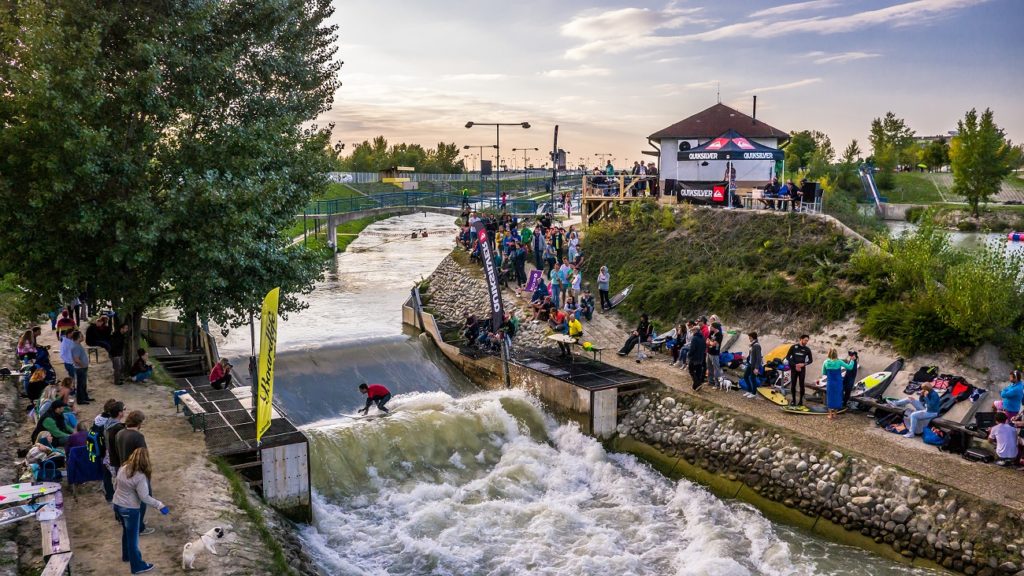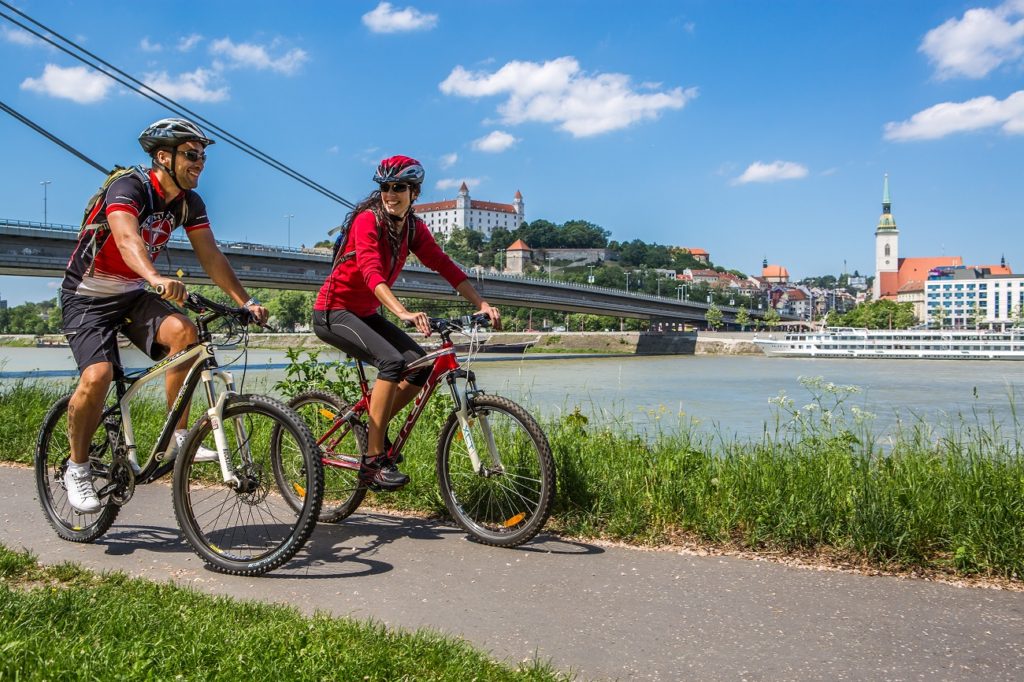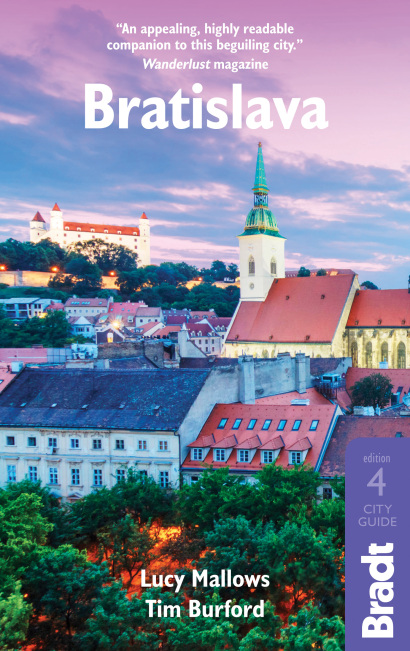Landlocked Slovakia might not be your first thought when it comes to a summer holiday in Europe, but you should think again. Slovakia’s climate is temperate, and average temperatures in summer are a balmy 24–26°C (75–79°F).
Leafy Bratislava offers a welcome retreat for those seeking a short summer break away from the crowds of southern Europe. In the height of summer, the River Danube moderates the heat in Bratislava and there are many green spaces in which to escape, countless lakes in which to cool off, and scores of leafy squares in which to enjoy an ice cream. Here is our pick of the best things to see and do in the city this summer.
Make a splash
People don’t swim in the Danube because of the strong current and pollution, but there are many local lakes where the water is pretty clean. The nearest of these is Zlaté Piesky (Golden Sands), a large, soft-water lake, with a water slide and beach volleyball. There’s a campsite at the resort where small cabins can be rented, and a nudist beach on the far side of the lake. Alongside is Wakelake, which offers wakeboarding and flyboarding (with jetpacks strapped to your feet…).

Also outside the city centre is Areál Divoká Voda, which offers plenty of watersports including rafting, kayaking, jet skiing, surfing and wakeboarding, as well as paintballing, beach volleyball, beach football, horse and pony riding. There are some of the best manmade channels in Europe for white-water rafting, with six levels of difficulty; they’re used by Olympic sportsmen and top Slovak slalom teams.
If you’d rather stay dry, all summer long Bratislava has its very own beach on the parkland right bank of the Danube, using imported sand for beach volleyball and tennis. There are hammocks, chairs and umbrellas, and there’s often outdoor film nights and live music. Although you can’t swim in the Danube, you can swim at the pool near the bar or participate in a group yoga class by the side of the river. Note that the mosquitos here are a nightmare, so make sure you take plenty of repellent.
Enjoy fantastic ice cream
Bratislava is in the midst of homemade ice cream fever. Everywhere you turn in the Old Town, you’ll see signs for ‘ice cream artigianale’ or ‘gelato’. This multi-lingual nature a pity, because zmrzlina is a brilliant Slovak word! It is quite onomatopoeic, as the lip licking ‘zmmmmr’ sound is just what we make after trying yet another divine, creamy creation.
Two of the best in town are:
Koun Barbara, of the brother & sister team behind Koun, studied at Gelato University Carpigiani in Bologna, & they make the best ice cream in Bratislava, if not all Slovakia! Different flavours every day, such as fig & ricotta, poppyseed, raspberry sorbet, walnut cream, amaretti. No preservatives, & there’s always a vegan option… Also hot waffles with ice cream (pizzelles) & brioche/ice-cream sandwiches.
Luculus The chilli-choc is divine & there is a dairy-free chocolate, too. Eat in or out, but there may be long (but socially distant) queues either way.
Explore the city’s green spaces
Bratislava is a very green city, with 809ha of parks and forests and 34 protected reservations. Most of this is formed by the Bratislava Forest Park to the north of the city, stretching for some 3,000ha into the Small Carpathian Mountains. The hills above the city make an excellent cool getaway from the heat of the summer, and they are criss-crossed with hiking trails and cycle paths.
One of the best places to soak up the city’s greenery is Kamzík Hill (439m), which offers cool woods and a range of trails to follow at the southernmost tip of the Small Carpathians. There are little triangular wooden huts, looking like chunks of Toblerone, offering draught beer or Kofola (a Czech version of Coca-Cola) on tap. In summer, a bobsleigh run follows the slope for 360m, with ten bends in the woods and a tunnel before emerging into a beautiful meadow. The revolving Veza restaurant and café are at the top of the 200m-high TV tower, providing wonderful views to accompany dinner or a drink.
Northwest of town, 20ha Horský Park is a woody area with a network of paths. There is a ‘Lourdes cave’, recalling the grotto of pilgrimage in France, with a Kalvária pilgrimage site founded in 1694 by the Jesuits, the city council and the archbishop, who decided to build it where the Turkish guards had stood in the time of their raids. The E8 hiking trail runs through the park, leading south to Slavín (15mins) and north to Kamzík (1hr 20mins), continuing along the length of the Small Carpathians.
For cyclists, there are various popular local routes near Bratislava; one follows the Danube east to Komárno, another swerves its way up the Small Carpathian Wine Route, and others run along the south bank of the Danube from Petržalka, west to the quaint town of Hainburg in Austria, and east to Danubiana and into Hungary.

A good route from Bratislava to Devín would be far more popular than these, but unfortunately the main road by the Danube is narrow and busy and cannot be widened owing to being in a protected area – alternatives are to cycle through the forest from Karlova Ves (8km), or to take a train to Devínska Nová Ves and then follow the excellent cycleway south along the Morava Valley to Devín (4.5km). This forms part of the EuroVelo 13 route, and is also lined with information boards describing the ecology of the Morava floodplain. A tributary of the Danube, the Morava marks the border between Slovakia and Austria north of Devín.
One of the best non-mountain birdwatching areas in Slovakia is Záhorie (the name means ‘behind the mountains’), which is conveniently close to Bratislava, beginning just to the north by the D2/E65 motorway and stretching to the Czech border. This is the flood plain of the Morava River along the Austrian border and is a complex of water meadows, marshes, bogs, ponds, pools, reed beds, pine, oak and poplar forest and damp willow and alder woodland. In spring and summer, white storks, red and black kites, collared flycatchers, penduline tits and red-backed shrikes are fairly common here. There are also plenty of walking and biking trails in the vicinity.
More information
Start planning your trip to Bratislava with our comprehensive guide:
